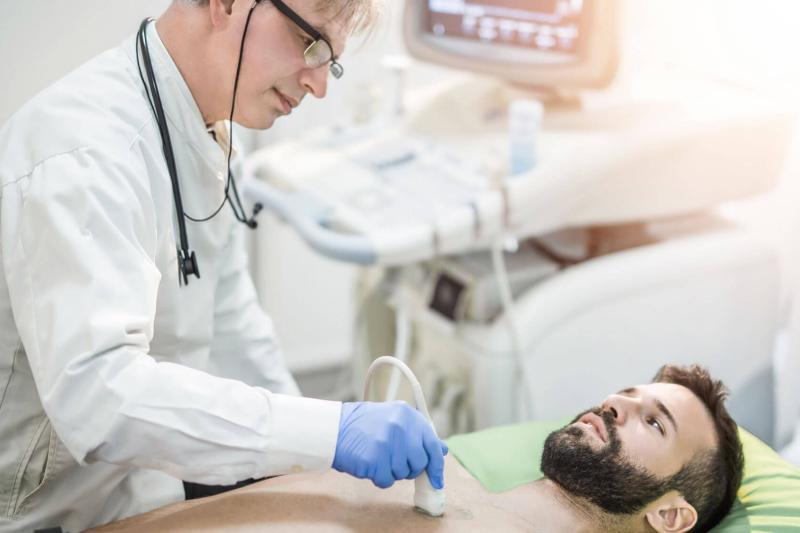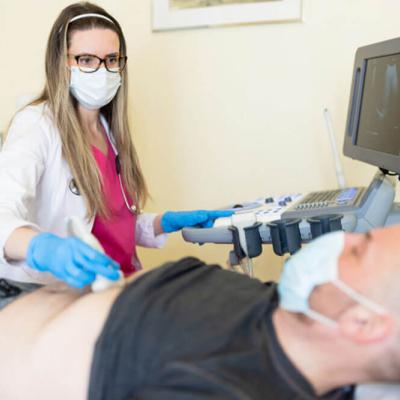- AdventHealth University

Demand for skilled diagnostic medical sonographers is booming. According to the U.S. Bureau of Labor Statistics, employment of diagnostic medical sonographers is projected to grow 19 percent from 2018 to 2028, much faster than the average for all occupations.
This project growth is unsurprising, considering how vital sonographers are to many facets of modern healthcare. Sonographers use advanced technology for many different uses, from gathering information crucial to identifying serious health conditions, to giving expectant parents a first glimpse of their baby. A particularly critical role is that of registered diagnostic cardiac sonographer, in which ultrasound technology is used to generate detailed images of the human heart, which can then be used to diagnose specific ailments and conditions.
Exploring Sonography Careers
Before exploring how to become a cardiac sonographer, it’s important to understand the specific technology and processes used in this profession. Healthline provides a helpful breakdown of sonography, sonograms, and ultrasounds. Sonography is a medical field where professionals use ultrasound diagnostic imaging technology to determine what medical ailments or afflictions a patient may be facing. Ultrasounds are sound waves that are emitted and captured to produce images of a person’s organs, vessels, and body. The images, called sonograms, are similar to other types of medical images, such as X-rays, but different in that ultrasounds do not use radiation to capture the images.
Cardiac sonographers are professionals who specifically focus on capturing sonograms of a person’s heart. These sonograms are called echocardiograms, and physicians can use them to evaluate the anatomy and hemodynamics, or blood flow, of the heart and its vessels. Echocardiograms can be performed after a patient is physically active or while a patient is at rest.
Cardiac sonographers often pursue areas of specialization, including adult echocardiography (AE), pediatric echocardiography (PE), and fetal echocardiography (FE).
How to Become a Cardiac Sonographer
Becoming a cardiac sonographer requires that professionals obtain an advanced education, develop professional skills, and acquire necessary credentials.
Aspiring cardiac sonographers first need to earn an associate or a bachelor’s degree in diagnostic medical sonography that is accredited by the Commission on Accreditation of Allied Health Education Programs (CAAHEP). While the educational requirements for particular roles may vary by organization, earning a bachelor’s degree may provide a competitive advantage for candidates seeking in-demand cardiac sonography roles.
Accredited sonography degree programs often consist of a mixture of didactic teachings, such as learning about specific sonography procedures and technology in a classroom setting, and clinical experience in which students actually work with sonography and ultrasound technology under the supervision of a credentialed sonographer in a clinical or health setting. Both types of learning methods are crucial to providing a holistic education for sonography professionals and preparing them for success in the field.
Those who successfully complete sonography programs will receive a certificate or credential to practice cardiac sonography. However, not all states require that cardiac sonographers hold credentials to practice. Aspiring cardiac sonographers should carefully consider the specific credentialing requirements of the state in which they want to work. CAAHEP notes that “certificate programs must ensure that the graduates of the program have obtained or will obtain a minimum of a bachelor’s degree, and a cardiac sonography or vascular specialist/technologist entry-level technical credential upon completion of the program.” Specific types of credentials can be gained from Cardiovascular Credentialing International (CCI) and the American Registry for Diagnostic Medical Sonography (ARDMS), which offers the Registered Diagnostic Cardiac Sonographer (RDCS) credential.
After completing an educational program and obtaining a certificate, individuals can then pursue employment opportunities at a range of health and medical facilities, including hospitals, outpatient facilities, medical diagnostic labs, cardiologist offices, and postsecondary institutions. Cardiac sonographers who work at hospitals may treat a wide range of patients. Those who work at outpatient facilities and medical diagnostic labs will work mostly with patients prior to or after a hospital visit. Cardiac sonographers who work at postsecondary institutions may focus less on treating patients and more on providing future professionals the skills and education they need to succeed in the field.
Pursuing Higher Education
After becoming a cardiac sonographer, anyone who wishes to advance in a health organization and the field in general can do so by pursuing advanced education. This can include bachelor’s or master’s degree programs, additional certificate programs, and educational degrees or credentials in other closely related medical fields. Cardiac sonographers should carefully consider their future career goals and what educational programs and certificates may be beneficial or necessary for those particular fields.
Working professionals who may not have the necessary time to commute to campus and attend classes should consider online programs like those offered by AdventHealth University Online. These programs provide more flexible options designed to fit into the lives of working professionals. AdventHealth University’s online degree in diagnostic medical sonography offers a comprehensive curriculum that includes coursework in sonography technology and practices, legal and business components of healthcare, and future trends and issues facing sonography, helping to ensure that students obtain a full-circle sonography education that will benefit them in their career endeavors. Learn more about how AdventHealth University Online’s program can help you make the most out of your career.
Recommended Readings
The Fastest Growing Healthcare Careers
What Is Medicare?
Leadership Styles in Nursing
Sources
AdventHealth University Online, Bachelor of Science in Diagnostic Medical Sonography
ARDMS, About ARDMS
ARDMS, ARDMS General Prerequisites
ARDMS, Registered Diagnostic Cardiac Sonographer (RDCS)
CAAHEP
Cardiovascular Credentialing International
Healthline, “Sonogram vs. Ultrasound”
U.S. Bureau of Labor Statistics, Diagnostic Medical Sonographers and Cardiovascular Technologists and Technicians, Including Vascular Technologists, Job Outlook
U.S. Bureau of Labor Statistics, Diagnostic Medical Sonographers and Cardiovascular Technologists and Technicians, Including Vascular Technologists,What Diagnostic Medical Sonographers and Cardiovascular Technologists and Technicians, Including Vascular


